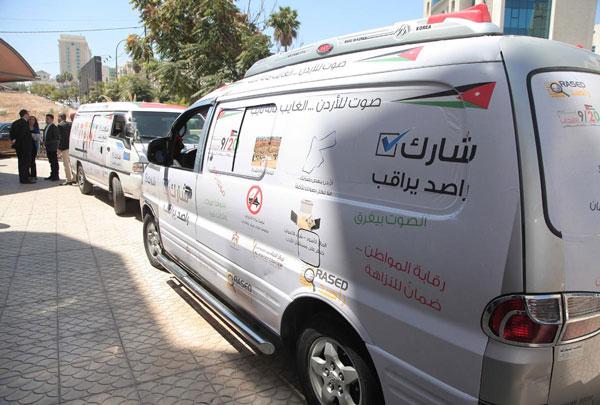You are here
‘258 women running in parliamentary elections’
By Bahaa Al Deen Al Nawas - Aug 22,2016 - Last updated at Aug 22,2016

A minivan used as part of the 'Sharek Sah' initiative, organised by Al Hayat Centre for Studies and the Ministry of Political and Parliamentary Affairs, to promote engagement in the elections is parked in Amman on Sunday. The minivans will tour the governorates to urge voters to cast their ballots (Petra photo)
AMMAN — Some 258 female candidates are running in the upcoming elections, up from 215 in the 2013 polls, Sisterhood Is Global Institute (SIGI) Executive Director Asma Khader said on Monday.
Speaking at a press conference, Khader, a former minister, said the increase in the number of women running for office was due to the 2015 Elections Law and changes to electoral districts.
Khader heads SIGI’s “Eye on Women in the Elections” project to monitor the elections from a gender perspective.
She said that of the 230 lists running in the September 20 elections, 198 lists, or 86 per cent, feature only one female candidate, while 23 lists, or 10 per cent, have more than one woman running.
Seven lists are male-only (3 per cent), and two lists are all-female.
Only one list, in Aqaba, features a woman with a disability.
Khader said the Eyes on Women in the Elections coalition is conducting comprehensive monitoring in seven electoral districts — Amman, Zarqa, Irbid, Ajloun, Karak, Balqa and Badia.
Information from other districts is taken from “credible sources”, including the coalitions’ reporters and field inspectors, and through cooperation with other election monitors, she noted.
The Independent Election Commission is scheduled to approve or reject the lists submitted by candidates on Thursday, Khader said, adding that all figures are provisional until then.
Candidates submitted applications for their lists last week, and Khader said it was a basic right of women to participate on the committees receiving the applications.
The law requires that a woman must be present on the committee, for example to check the identity of female candidates wearing the niqab, a face veil, and also to provide moral support to women candidates.
The highest ratios of women’s candidacy are in the three badia regions; northern (36.6 per cent), central (28.6 per cent) and southern (25.8 per cent), the SIGI’s executive director said, followed by Aqaba (25.8 per cent), Ajloun (24.13 per cent), Irbid’s fourth electoral district (23.93 per cent), Amman’s first electoral district (23.3 per cent), Madaba (22.9 per cent) and Mafraq (21.87 per cent).
The districts with the lowest participation of women are Karak and Amman’s 2nd District (15.78 per cent), Balqa (15 per cent) and Irbid’s 1st District (14.75 per cent).
“All those figures debunk previous statements that there are not many female candidates,” Khader said.
Twenty-one female candidates have previously served as lawmakers, including 14 who were members of the last Parliament, she added.
Related Articles
AMMAN — The women’s movement has expressed optimism that some female parliamentary candidates could clinch seats outside the 15-seat designa
AMMAN — Women’s rights activists on Thursday said that the disappointing results for women candidates in the parliamentary elections was exp
AMMAN — Women’s organisations should work to develop a discourse that appeals to MPs with diverse views, according to Salma Nims, secretary












